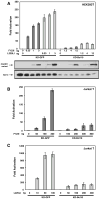Oncogenic CARD11 mutations induce hyperactive signaling by disrupting autoinhibition by the PKC-responsive inhibitory domain
- PMID: 20799731
- PMCID: PMC2943563
- DOI: 10.1021/bi101052d
Oncogenic CARD11 mutations induce hyperactive signaling by disrupting autoinhibition by the PKC-responsive inhibitory domain
Abstract
The regulated activation of NF-κB by antigen receptor signaling is required for normal B and T lymphocyte activation during the adaptive immune response. Dysregulated NF-κB activation is associated with several types of lymphoma, including diffuse large B cell lymphoma (DLBCL). During normal antigen receptor signaling, the multidomain scaffold protein CARD11 undergoes a transition from a closed, inactive state to an open, active conformation that recruits several signaling proteins into a complex, leading to IKK kinase activation. This transition is regulated by the CARD11 inhibitory domain (ID), which participates in intramolecular interactions that prevent cofactor binding to CARD11 prior to signaling, but which is neutralized after receptor engagement by phosphorylation. Several oncogenic CARD11 mutations have been identified in DLBCL that enhance activity and that are mostly found in the coiled-coil domain. However, the mechanisms by which these mutations cause CARD11 hyperactivity and spontaneous NF-κB activation are poorly understood. In this report, we provide several lines of evidence that oncogenic mutations F123I and L225LI induce CARD11 hyperactivity by disrupting autoinhibition by the CARD11 ID. These mutations disrupt ID-mediated intramolecular interactions and ID-dependent inhibition and bypass the requirement for ID phosphorylation during T cell receptor signaling. Intriguingly, these mutations selectively enhance the apparent affinity of CARD11 for Bcl10, but not for other signaling proteins that are recruited to CARD11 in an ID-dependent manner during normal antigen receptor signaling. Our results establish a mechanism that explains how DLBCL-associated mutations in CARD11 can initiate spontaneous, receptor-independent activation of NF-κB.
Figures











Similar articles
-
Intramolecular Interactions and Regulation of Cofactor Binding by the Four Repressive Elements in the Caspase Recruitment Domain-containing Protein 11 (CARD11) Inhibitory Domain.J Biol Chem. 2016 Apr 15;291(16):8338-48. doi: 10.1074/jbc.M116.717322. Epub 2016 Feb 16. J Biol Chem. 2016. PMID: 26884334 Free PMC article.
-
A quantitative signaling screen identifies CARD11 mutations in the CARD and LATCH domains that induce Bcl10 ubiquitination and human lymphoma cell survival.Mol Cell Biol. 2013 Jan;33(2):429-43. doi: 10.1128/MCB.00850-12. Epub 2012 Nov 12. Mol Cell Biol. 2013. PMID: 23149938 Free PMC article.
-
Cooperative Control of Caspase Recruitment Domain-containing Protein 11 (CARD11) Signaling by an Unusual Array of Redundant Repressive Elements.J Biol Chem. 2016 Apr 15;291(16):8324-36. doi: 10.1074/jbc.M115.683714. Epub 2016 Feb 16. J Biol Chem. 2016. PMID: 26884335 Free PMC article.
-
Mechanisms of Regulated and Dysregulated CARD11 Signaling in Adaptive Immunity and Disease.Front Immunol. 2018 Sep 19;9:2105. doi: 10.3389/fimmu.2018.02105. eCollection 2018. Front Immunol. 2018. PMID: 30283447 Free PMC article. Review.
-
Reconsidering phosphorylation in the control of inducible CARD11 scaffold activity during antigen receptor signaling.Adv Biol Regul. 2021 Jan;79:100775. doi: 10.1016/j.jbior.2020.100775. Epub 2020 Dec 18. Adv Biol Regul. 2021. PMID: 33358178 Free PMC article. Review.
Cited by
-
Genetic Events Inhibiting Apoptosis in Diffuse Large B Cell Lymphoma.Cancers (Basel). 2021 Apr 30;13(9):2167. doi: 10.3390/cancers13092167. Cancers (Basel). 2021. PMID: 33946435 Free PMC article. Review.
-
Clinical and Genetic Heterogeneity of CARD14 Mutations in Psoriatic Skin Disease.Front Immunol. 2018 Oct 16;9:2239. doi: 10.3389/fimmu.2018.02239. eCollection 2018. Front Immunol. 2018. PMID: 30386326 Free PMC article. Review.
-
Genetic screening in a Brazilian cohort with inborn errors of immunity.BMC Genom Data. 2023 Aug 17;24(1):47. doi: 10.1186/s12863-023-01148-z. BMC Genom Data. 2023. PMID: 37592284 Free PMC article.
-
Gain-of-function mutations in CARD11 promote enhanced aggregation and idiosyncratic signalosome assembly.Cell Immunol. 2020 Jul;353:104129. doi: 10.1016/j.cellimm.2020.104129. Epub 2020 May 14. Cell Immunol. 2020. PMID: 32473470 Free PMC article.
-
Novel drug targets for personalized precision medicine in relapsed/refractory diffuse large B-cell lymphoma: a comprehensive review.Mol Cancer. 2015 Dec 11;14:207. doi: 10.1186/s12943-015-0474-2. Mol Cancer. 2015. PMID: 26654227 Free PMC article. Review.
References
-
- Schulze-Luehrmann J, Ghosh S. Antigen-receptor signaling to nuclear factor kappa B. Immunity. 2006;25:701–715. - PubMed
-
- Thome M, Weil R. Post-translational modifications regulate distinct functions of CARMA1 and BCL10. Trends Immunol. 2007;28:281–288. - PubMed
-
- Rawlings DJ, Sommer K, Moreno-Garcia ME. The CARMA1 signalosome links the signalling machinery of adaptive and innate immunity in lymphocytes. Nat Rev Immunol. 2006;6:799–812. - PubMed
Publication types
MeSH terms
Substances
Grants and funding
LinkOut - more resources
Full Text Sources
Medical
Research Materials

